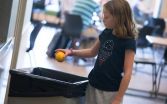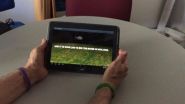(Press-News.org) In early August, biologist Peter Ward returned from the South Pacific with news that he encountered an old friend, one he hadn't seen in over three decades. The University of Washington professor had seen what he considers one of the world's rarest animals, a remote encounter that may become even more infrequent if illegal fishing practices continue.
The creature in question is Allonautilus scrobiculatus, a species of nautilus that Ward and a colleague had previously discovered off of Ndrova Island in Papua New Guinea. Nautiluses are small, distant cousins of squid and cuttlefish. They are an ancient lineage of animal, often christened a "living fossil" because their distinctive shells appear in the fossil record over an impressive 500 million year period. Ward says this recent sighting of Allonautilus indicates that there is still much to learn about these creatures.
"Before this, two humans had seen Allonautilus scrobiculatus," said Ward, who holds appointments at the UW in both the Department of Biology and the Department of Earth and Space Sciences. "My colleague Bruce Saunders from Bryn Mawr College found Allonautilus first, and I saw them a few weeks later."
Those sightings were in 1984, when Ronald Reagan was finishing his first term as president and the oldest millennials were starting preschool. Ward and Saunders collected several Allonautilus scrobiculatus specimens for analysis and realized that their gills, jaws, shell shape and male reproductive structures differ significantly from other nautilus species.
"Some features of the nautilus -- like the shell giving it the 'living fossil' label -- may not have changed for a long time, but other parts have," said Ward.
Allonautilus also sports a distinctive accessory clearly visible in photographs.
"It has this thick, hairy, slimy covering on its shell," said Ward. "When we first saw that, we were astounded."
This slimy nautilus turned out to be even more elusive than its siblings. Aside from another brief sighting by Saunders in 1986, Allonautilus disappeared until July 2015, when Ward returned to Papua New Guinea to survey nautilus populations. Since nautiluses are expert scavengers, Ward and his colleagues set up "bait on a stick" systems each evening -- fish and chicken meat suspended on a pole between 500 and 1,300 feet below the surface -- and filmed activity around the bait for 12 hours.
"We started using this approach in 2011," said Ward. "This year, there were about 30 guys involved and each day we would all watch the movies from the night before at 8X speed. There were a lot of 'ohs' and 'ahs'."
One night's footage from a site off of Ndrova Island showed an Allonautilus approach the bait after a 31-year absence from Ward's life. It was soon joined by another nautilus, and the two fought for access to the bait until a sunfish arrived on the scene.
"For the next two hours, the sunfish just kept whacking them with its tail," said Ward.
The team also used baited traps to capture several nautiluses, including Allonautilus, at a depth of about 600 feet. Since most nautiluses do not like the heat, the researchers brought them to the surface in chilled water to obtain small tissue, shell and mucous samples and measure the dimensions of each animal. They then transported the animals back to their capture site and released them.
Ward and his colleagues used this information to determine the age and sex of each animal, as well as the diversity of each nautilus population in the South Pacific. Through these studies, they have learned that most nautilus populations are isolated from one another because they can only inhabit a narrow range of ocean depth.
"They swim just above the bottom of wherever they are," said Ward. "Just like submarines, they have 'fail depths' where they'll die if they go too deep, and surface waters are so warm that they usually can't go up there. Water about 2,600 feet deep is going to isolate them."
These restrictions on where nautiluses can go mean that populations near one island or coral reef can differ genetically or ecologically from those at another. The findings also pose a challenge for conservationists.
"Once they're gone from an area, they're gone for good," said Ward.
Illegal fishing and "mining" operations for nautilus shells have already decimated some populations, Ward said. This unchecked practice could threaten a lineage that has been around longer than the dinosaurs were and survived the two largest mass extinctions in Earth's history. In September, the U.S. Fish and Wildlife Service will decide whether to advocate for nautiluses to become a protected species under the Convention on International Trade in Endangered Species of Wildlife Fauna and Flora, or CITES treaty. Such protection could curb international trade in nautilus shells, with the aim of reducing nautilus harvests across the Pacific.
"As it stands now, nautilus mining could cause nautiluses to go extinct," said Ward.
Ward hopes to see Allonautilus again, especially since he would like to study how this species, which arose relatively recently according to genetic tests, behaves differently from other nautiluses. Its rarity makes this endeavor challenging.
"It's only near this tiny island," said Ward. "This could be the rarest animal in the world. We need to know if Allonautilus is anywhere else, and we won't know until we go out there and look."
Ward's main partners in this field season included Richard Hamilton and Manuai Matawai from the Nature Conservancy and Greg Barord from the City University of New York. More than 30 fisheries experts, guides and local residents in the Admiralty Islands and the Bismarck Archipelago of Papua New Guinea also provided crucial aid and support, Ward said. Their work is funded by National Geographic, the National Science Foundation's Division of Polar Programs and the Tiffany & Co. Foundation.
INFORMATION:
For more information, contact Ward at 206-327-7326 or ward.biology.uw@gmail.com.
Link to full release with images:
http://www.washington.edu/news/2015/08/25/rare-nautilus-sighted-for-the-first-time-in-three-decades/
RIVERSIDE, Calif. - Barley, a widely grown cereal grain commonly used to make beer and other alcoholic beverages, possesses a large and highly repetitive genome that is difficult to fully sequence. Now a team led by scientists at the University of California, Riverside has reached a new milestone in its work, begun in 2000, on sequencing the barley genome. The researchers have sequenced large portions of the genome that together contain nearly two-thirds of all barley genes.
The new information, published in The Plant Journal, will not only expand geneticists' knowledge ...
A recent randomized trial conducted by researchers at Abbott Northwestern Hospital, part of Allina Health, found that inpatient palliative care (PC) visits were associated with improved quality of life and symptom burden for patients with heart failure (HF).
Because of these results, Abbott Northwestern conducted a new study, "A Description of Inpatient Palliative Care Actions for Patients with Acute Heart Failure," published June 30 by the American Journal of Hospice and Palliative Medicine. The study aimed to identify and describe what actions PC providers took to ...
BOSTON - A new study led by researchers at Boston Medical Center (BMC) indicates that variations in opioid receptor genes are associated with more severe neonatal abstinence syndrome (NAS) in newborn babies. The findings, published online in Drug & Alcohol Dependence, could help lead to the development of individualized treatment plans tailored to each infants' risk of requiring medication to curb their NAS symptoms, which could help improve these patients' outcomes and reduce how long some stay in the hospital.
NAS is present in newborn babies who have been exposed ...
Jaclyn Tabor and Jessica Calarco tap a novel data source to track changing attitudes toward parenting during the 20th and early 21st centuries: cartoons in the New Yorker magazine.
"We find that portrayals of children and child-rearing are both more varied and more fluctuating than existing research would suggest," said Tabor, an Indiana University Bloomington doctoral student in sociology. "Contemporary cartoons celebrate children but also recognize the significant challenges children create for parents. Cartoons from the 1920s and 1930s -- when rates of childlessness ...
Less than a month before Congress votes on whether to reauthorize a controversial program mandating healthier school lunches, a new study confirms the suspicions of school officials - many students are putting the fruits and vegetables they're now required to take straight into the trash, consuming fewer than they did before the law took effect.
The new study, published online in Public Health Reports on Aug. 25, is the first to use digital imaging to capture students' lunch trays before and after they exited the lunch line.
It is also one of the first to compare fruit ...
People of all ages recently lined up to do some fishing at the Museum of Science in Boston. And oddly, the fish they hoped to hook were not good ones.
Museum goers were invited to play "Fish Police!!" is a video game that challenged players to rid a river of its bad fish, while sparing its good ones. The catch? All the fish looked exactly alike, and could be told apart only by the way a fish puffed in size: a bad fish puffed just a little faster. After all, it was nervous that it would be caught.
The game's premise may sound a little fishy, but it has helped a team ...
Amsterdam, NL, August 25, 2015 - Patients with relapsing-remitting multiple sclerosis (RR-MS), the most common form of the disease, often have deficits in two neuropsychological functions, autobiographical memory (AM) and episodic future thinking (EFT), which impact quality of life. In a new study published in Restorative Neurology and Neuroscience, researchers report that training RR-MS patients in mental visual imagery (MVI) can improve AM/EFT functioning.
AM facilitates the ability to remember personal detailed events within a specific location and timeframe. EFT enables ...
Murderers who kill intimate partners and family members have a similar profile
One-third of all women murdered in U.S. are killed by male partners
Wives and family members wrongly think 'my husband or son would never hurt me'
CHICAGO --- Murderers who kill intimate partners and family members have a significantly different psychological and forensic profile from murderers who kill people they don't know, reports a new Northwestern Medicine study that examined the demographics, psychiatric history and neuropsychology of these individuals.
The new knowledge about ...
HOUSTON, August 25, 2015 - Pancreatic cancer is extremely deadly and often has a poor prognosis. Ranked as the fourth deadliest cancer in the U.S. and poised to move up within the next few years, pancreatic cancer is very difficult to detect in its early stages. Seldom diagnosed early and typically spreading rapidly, the disease has no effective treatment once it advances.
University of Houston researchers are on a mission to develop drugs that will allow physicians to prolong patient survival and, possibly, even eradicate this deadliest of cancers.
"Our research ...
Two studies in the August 25 issue of JAMA examine the effect of physical activity and nutrient supplementation on cognitive function.
In one study, Kaycee M. Sink, M.D., M.A.S., of the Wake Forest School of Medicine, Winston-Salem, N.C., and colleagues evaluated whether a 24-month physical activity program would result in better cognitive function, lower risk of mild cognitive impairment (MCI) or dementia, or both, compared with a health education program.
Epidemiological evidence suggests that physical activity is associated with lower rates of cognitive decline. ...



